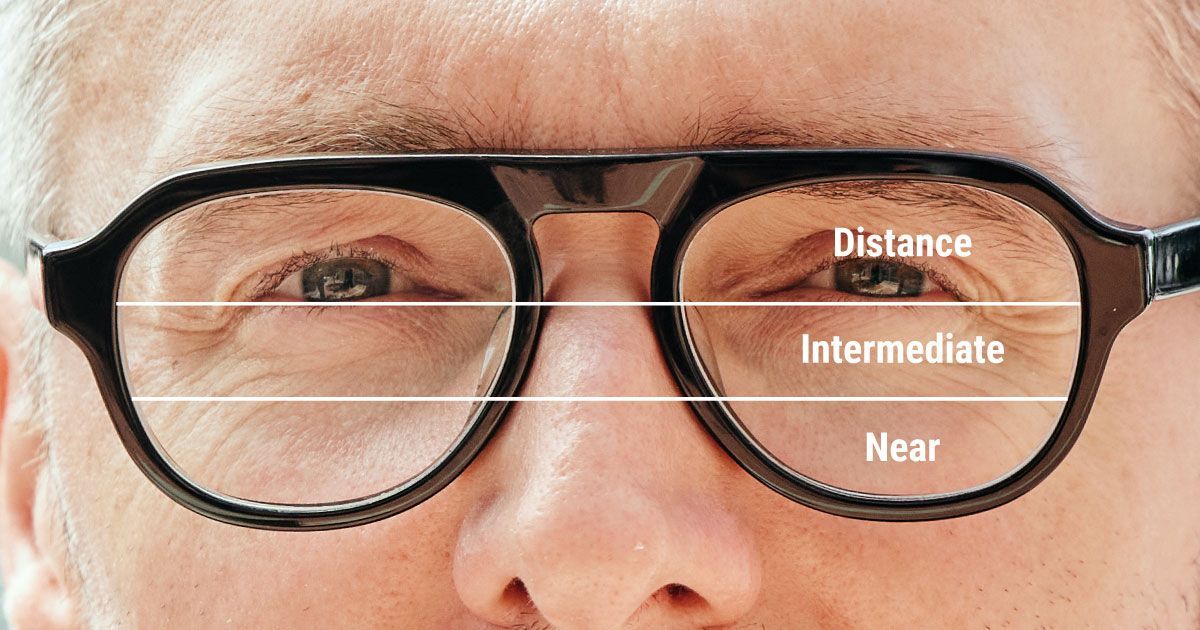Progressive Lenses: The Modern Solution for Clear Vision at Every Distance

Read time: 4 minutes
For anyone over the age of 40, changes in vision can become more noticeable - especially when it comes to reading up close. This common, age-related condition called presbyopia makes it harder to focus on nearby objects. For decades, bifocals and reading glasses were the standard solutions. But today’s patients are increasingly turning to a more advanced and seamless option: progressive lenses.
What Are Progressive Lenses?
Progressive lenses are multifocal lenses designed to correct near, intermediate, and distance vision all in a single, continuous lens - without visible lines. Unlike bifocals or trifocals, which have abrupt visual transitions marked by noticeable lines, progressives offer a gradual change in lens power from top to bottom:
- The upper portion helps with distance vision (driving, watching TV)
- The middle section is optimized for intermediate vision (computer work)
- The lower area assists with close-up tasks (reading, texting)
This design allows for smooth, natural vision at every distance, making progressive lenses a preferred option for many people dealing with presbyopia.
A Brief History of Progressives
Progressive lenses were first introduced in 1959 by the French optical company Essilor, under the brand name Varilux. This marked a significant advancement over traditional bifocals, which had been in use since Benjamin Franklin's time. Early progressive designs were revolutionary but came with limited peripheral clarity and narrower reading zones.
Since then, technology has evolved dramatically. Today’s lenses use digital surfacing and freeform manufacturing, which allow for highly customized, precise optical zones tailored to the patient’s prescription, lifestyle, and frame choice. These innovations have made progressives more effective, comfortable, and easier to adapt to than ever before.
Who Needs Progressive Lenses?
Progressives are primarily designed for people with presbyopia, which typically begins around age 40 and gradually worsens with age. Anyone who finds themselves switching between reading glasses and distance glasses - or struggling with over-the-counter readers - may benefit.
They’re also ideal for:
- People with multiple vision corrections (e.g., nearsightedness and presbyopia)
- Professionals who use computers and need sharp intermediate vision
- Patients seeking a modern, line-free look without switching glasses
If you’re curious about the root cause of these age-related changes, you can learn more about what causes presbyopia.
What to Expect When You Start Wearing Them
Adjusting to progressive lenses takes time. Your eyes and brain need to learn how to “look” through different parts of the lens for various tasks.
Tips for getting used to progressives:
- Wear them consistently without switching back and forth with old glasses, as it can slow adaptation.
- Point your nose toward what you're looking at, rather than just moving your eyes.
- Move your head, not just your eyes, when shifting focus between distances.
- Start slowly and wear them at home or in familiar environments before driving or working long hours.
Most people adjust within a few days to a few weeks. However, it’s not uncommon for first-time wearers to need a brief period of coaching or a slight prescription tweak to get the perfect fit.
Many patients who spend long hours working on screens find that progressives provide a smoother, more comfortable viewing experience throughout the day. Advanced coatings and lens enhancements can also reduce fatigue and glare associated with screen time. Learn more about understanding and preventing digital eye strain.
Are Progressive Lenses Right for Everyone?
While progressives are a great solution for many, they’re not ideal for every situation. Patients with specific visual needs - such as those requiring very large reading zones for extended close work - or those with balance issues or certain neurological conditions may need alternative options like occupational lenses or task-specific glasses.
Still, modern lens designs have made progressive lenses accessible and comfortable for a broader range of users than ever before.
If you're unsure which type of lenses fit your visual and lifestyle needs, explore our guide to choosing the right lenses for your lifestyle.
Contemporary Usage and Trends
Progressive lenses have become the standard of care for presbyopia in many parts of the world. According to recent industry data, more than half of all multifocal lens prescriptions in the U.S. are now for progressives, and adoption continues to rise as lens technology improves.
High-end designs even include personalized options based on eye movement patterns, frame shape, and lifestyle habits - especially useful for tech-savvy patients who switch between screens and paper, indoors and outdoors.
At Urban Optiks Optometry, we offer a curated selection of advanced progressive lenses, including digitally surfaced and premium freeform designs, for enhanced clarity and comfort across all viewing distances.
The Takeaway
Progressive lenses are a sophisticated, all-in-one solution for patients with presbyopia, offering clear, comfortable vision at every distance - without the need for multiple pairs of glasses or dated bifocal lines. With today’s innovations, adapting is easier than ever, and the results are well worth it.
If you’re ready to upgrade your vision experience, schedule a personalized fitting at Urban Optiks. We’ll guide you through lens options that match your prescription, lifestyle, and style preferences—because clear vision should never come with compromise.
Share this blog post on social or with a friend:
The information provided in this article is intended for general knowledge and educational purposes only and should not be construed as medical advice. It is strongly recommended to consult with an eye care professional for personalized recommendations and guidance regarding your individual needs and eye health concerns.
All of Urban Optiks Optometry's blog posts and articles contain information carefully curated from openly sourced materials available in the public domain. We strive to ensure the accuracy and relevance of the information provided. For a comprehensive understanding of our practices and to read our full disclosure statement, please click here.


















